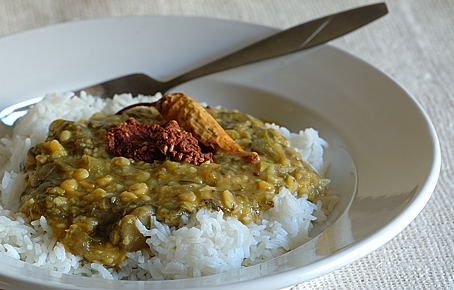Cooking with Green Leafy Vegetables
by Shyamala Kallianpur
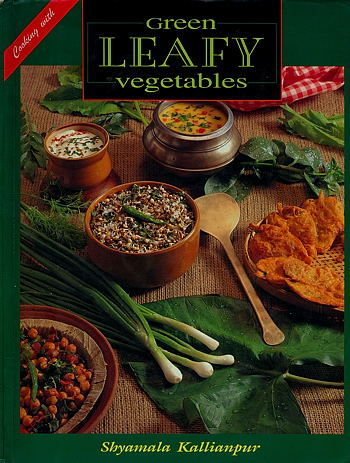
Published in 1997 by Shyamala Kallianpur at Secunderabad, in Andhra Pradesh, India. ISBN 81-7525-059-3. (Click on the Bookcover for Author’s image)
If I were Eve in the Garden of Eden, the genesis of my fall from grace might not be the rosy apple, but the seemingly mundane edible greens. Such is the sway that this earthy bounty holds over my taste and imagination. They beckon me at markets with their dewy-fresh looks in variegated shades of green and their promise of glowing health. Thus, each weekend sees the grand entry of a motley bunch into my kitchen. Some of them get used up quickly in a zuNka, aloo-somegreenorother, or a soup. Then my inner child awakens and begins to clamour for something different. This would trigger a search through my cookbooks while the greens waited in anticipation and then shrivelled up with disappointment. For, my cookbooks have plenty of vegetable recipes, but leafy vegetables are almost an afterthought. Even in books that provide a respectable number of greens recipes, the varieties are restricted to spinach and methi, and sometimes mustard leaves. Part of this negligence stems out of certain inherent traits of edible greens; namely, they tend to be stubbornly local and seasonal. Most of them are not amenable to traveling long distances; hence, there are variations in the types of greens found even between neighbouring states. Cookery books intended to reach a pan-Indian or global audience cannot afford to waste space on recipes with main ingredients that are not found everywhere or at all times. It is perhaps a reflection of this constraint that the only cookbook in English on green leafy vegetables in India is self-published by the author.
Cooking with Green Leafy Vegetables by Shyamala Kallianpur should not have gone out of print. It is the only book that provides recipes for over 30 different kinds of edible greens found in India. It has clear colour photographs of about 35 varieties of leafy vegetables. More importantly, greens are treated with the care and respect they deserve. With a couple of exceptions (such as the Sindhi Sai Bhaji), the recipes never involve pressure-cooking the leafy vegetables or overpowering them with spices. They are steamed, sometimes fried, or cooked just until soft or wilted. Thus, the greens retain their flavour, colour, and nutrients in the final dish. The author also demonstrates a meticulousness that is not often seen in Indian cookbooks. For example, she explains the difference between “roughly cutâ€Â, “chopâ€Â, and “finely cut†for leafy vegetables. She not only explains her rationale for giving the measurements for greens in volume, but further tells you how to measure them in the cup (“do not press….but just fill itâ€Â). There are many traditional recipes from different regions of India; however, there are also enough innovative dishes to satisfy the need to do something different once in a while.

The chapters are organized according to specific greens: the commonly available ones such as spinach, methi, amaranth, Malabar spinach (see photo below), and cabbage have separate chapters. Within these chapters, the recipes run the gamut from dry sabzi and gravies to soups, snacks, and salads; especially for the first four of the aforementioned greens. With 64 recipes for these greens, I am now never at a loss when faced with yet another bundle of spinach or methi. The chapter titled Other Leafy Vegetables deals with other easily-available greens such as bathua, green-stemmed and purple-stemmed colocasia leaves, coriander leaves, curry leaves, gongura, kulfa (purslane, paruppu keerai), ambat chuka (khatta palak), mint, mustard leaves, manathakali leaves, spring onion stalks, and saranti saag (ponnanganni). It is the last chapter, however, that I find the most interesting. Rather awkwardly titled, Some More “Other Leafy Vegetables†covers greens that grow in home gardens and are not available in the market, or not used much despite their market availability. Here you will find recipes for beetroot leaves, cauliflower greens, radish leaves, carrot greens, garlic leaves, pumpkin leaves, pomegranate leaves, drumstick leaves, tamarind leaves, brahmi, shepu (dill) taikiLo, omum (celery) leaf, and gherkin (kundru) leaf. There are only a few recipes for each of these vegetables, but the book gives a glimpse of the sheer expanse of possibilities that exists with edible greens.
Before writing this review I tried, rather unsuccessfully, to find the total number of edible leafy vegetables that grow in India. It is no secret that the undocumented heritage of Indian cuisines far exceeds the documented, but I can think of no other area, besides edible greens, where this truism applies more strongly. This study identified 42 species of plants with edible leaves or flowers in a single district in West Bengal. Our awareness is limited to only those greens that make it to the market, either through wholesalers or small village vendors who sell seasonal homegrown fare. Kallianpur’s book should have been just one in a long series of such works by various authors from several Indian states. This might be a tall order for commercial publishers, but an initiative funded by the government or NGOs with a nationwide reach might be one of the ways to highlight this rich culinary biodiversity and preserve it from the forest-fires of globalization.
Recipe: Kothchol (Indian Red Spinach with Bottle Gourd)
Adapted from Shyamala Kallianpur’s Cooking with Green Leafy Vegetables

Top: Malabar spinach, also known as Indian Red Spinach. Bottom: Bottle gourd
Ingredients:
Chopped Indian red spinach – 4 cups
Tender stalks of the spinach, cut into 2-cm length – 2 cups
Bottle gourd – ¼ kg (peeled and diced into small cubes)
Jaggery – 1 tablespoon
Salt to taste
Grind to a fine paste:
Grated coconut – 1 cup
Dried red chillies – 5 (sauté them in a little bit of oil first)
Raw rice – 1 tablespoon (soak it water for 10 minutes)
Tamarind – one lime-sized ball (use less if your tamarind is strong)
Tempering:
Oil – 1 teaspoon
Garlic – 8 to 10 cloves, crushed (no need to peel).
Method:
Take the chopped stalks in a vessel, add one cup of water, cover and cook on low heat till the stalks are tender. Then add the diced bottle gourd and salt. Cover and cook until the bottle gourd is just-cooked, but not too soft. Now add the chopped spinach, jaggery, and ground masala. Bring to a boil and simmer until the spinach is cooked. Remove from heat. Prepare the tempering: heat oil in a small pan or tempering vessel and sauté the garlic, but do not let it brown. Pour the oil and garlic pieces onto the hot cooked vegetables and cover them quickly. Keep for five to ten minutes, then serve hot with rice.
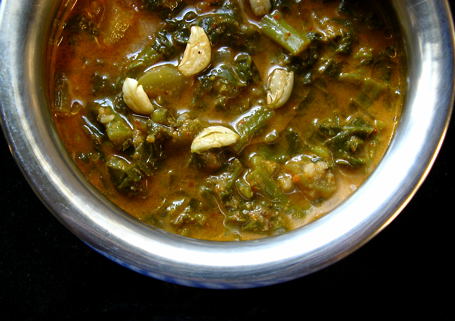
This is a typical dish from Shyamala Kallianpur’s Chitrapur Saraswat community.
Text and Photos: Veena Parrikar
Previously in the Cookery, Indic series:
Introduction
Salads for All Occasions – Vijaya Hiremath

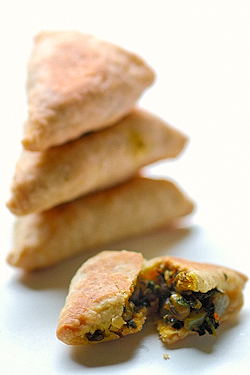








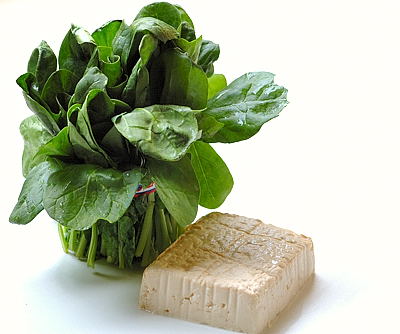



 Centre: Spinach and sprouted wheat. Clockwise from left: carrots, cabbage, tomatoes,
Centre: Spinach and sprouted wheat. Clockwise from left: carrots, cabbage, tomatoes, 





